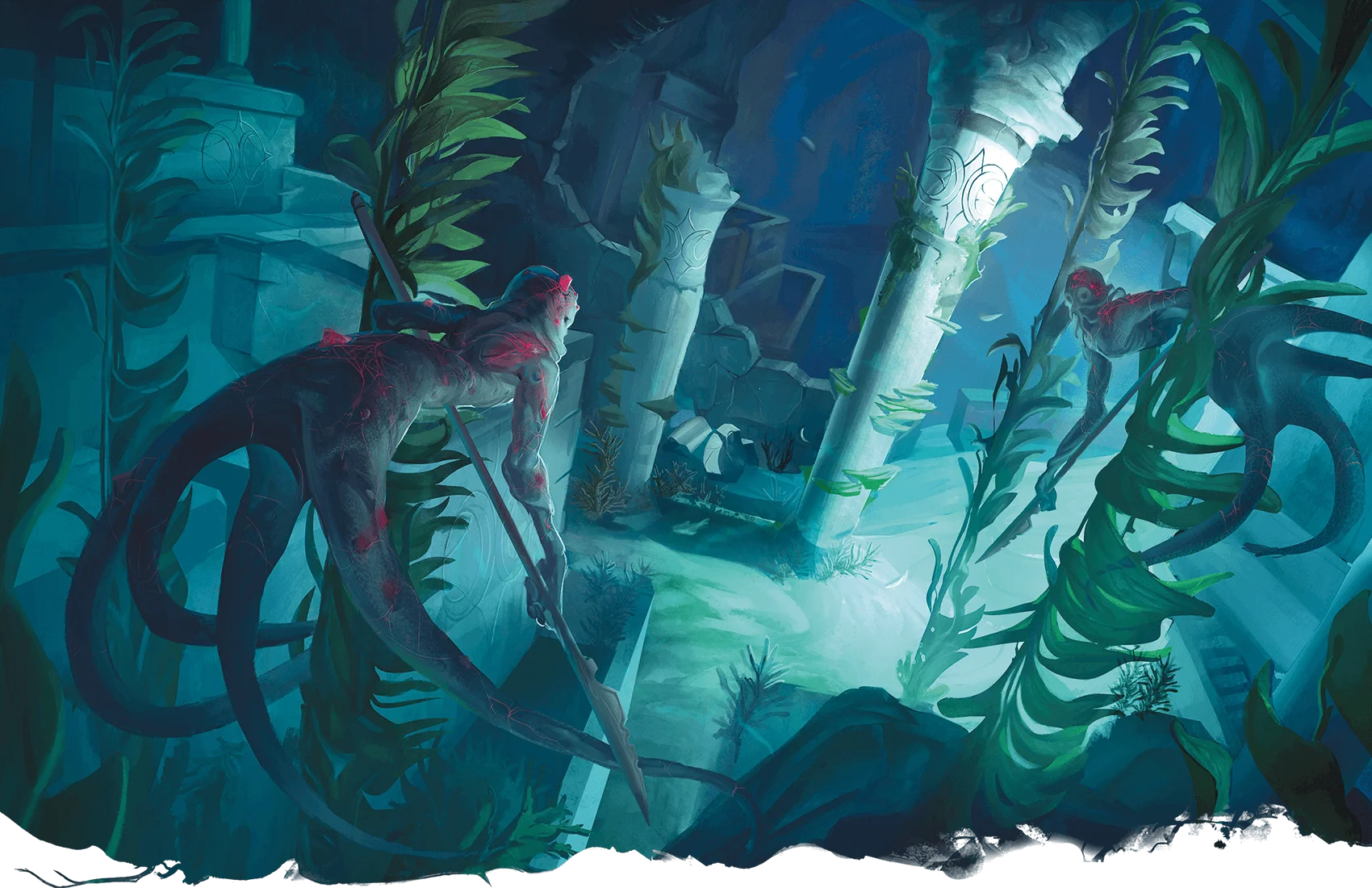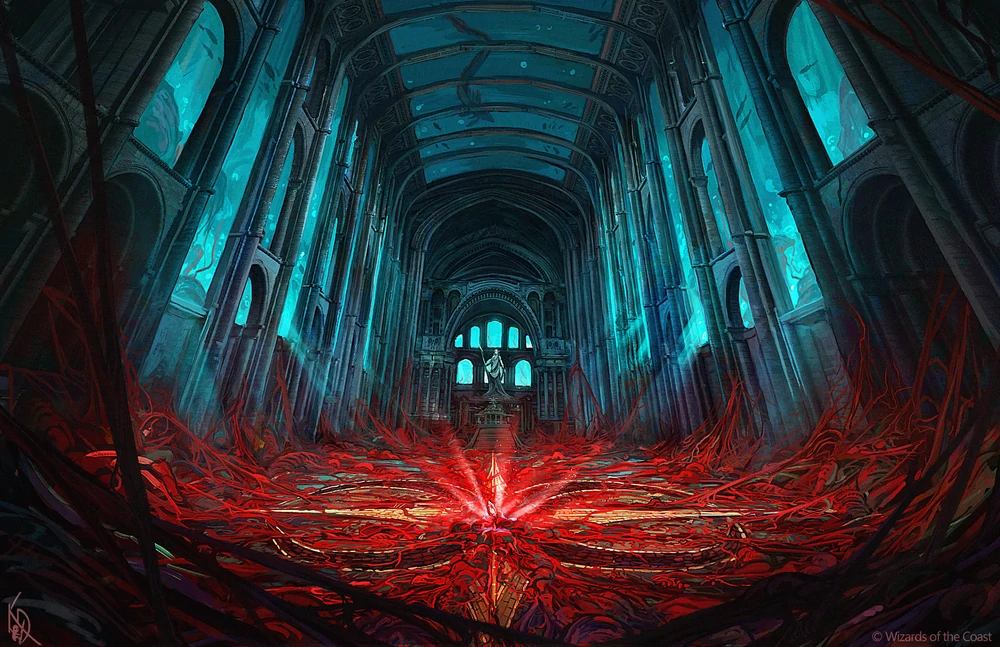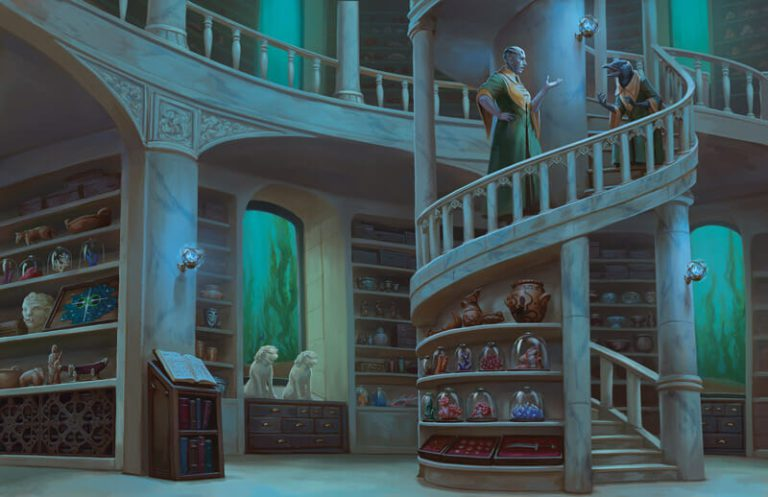The next stage of Call of the Netherdeep are the faction missions: Each faction has a series of six missions which start in Ank’harel, take the PCs into the sunken city of Cael Morrow, and eventually lead them into the Netherdeep. But we’re going to skip ahead to Cael Morrow itself, because — as the setting for half of the faction missions — we really need to get it straightened out before we can meaningfully work on the missions.
(Ank’harel itself is just fine, except for the fact that locations weren’t keyed to the map for some reason. So you’ll want to do that.)
This is, unfortunately, where your remix of the campaign is going to start getting harder. The key thing here is that:
- Cael Morrow is a vast sunken city; but
- The mapped section of Cael Morrow designed for the PCs to actually explore is a very, very tiny archaeological site (barely a few hundred feet across).
And the elephant in the room is that all the faction missions are written as if they were set in the entire, vast city of Cael Morrow, despite the fact that, in reality, they’re only set in the tiny, tiny archaeological site.
For example, in one mission the archaeological dig leader is concerned because one of his researchers has been missing for three days and he has no idea where she might be.
Where is she?
Two hundred feet away, straight down a linear corridor.
On a broader level, all the faction missions set in Cael Morrow are framed the same way:
Seven days after the end of their last mission, the characters are invited to meet Aradrine…
Seven days after the PCs successfully complete mission 4, Aradrine invites them…
Seven days after they successfully complete mission 5, Aradrine briefs the characters on their next assignment…
All three sets of factions are set up in the same way: The PCs do a short mission, then a full week passes, and then they’re given another mission.
But this is never going to actually happen because (a) the PCs have nothing else to do between missions and (b) the entirety of Cael Morrow consists of only seventeen keyed locations, so even if they haven’t fully explored the entire site during their first mission to the sunken city (which is quite plausible), they’ll certainly have done so before they get their next mission.
So you’ve got a couple choices here.
OPTION #1: REWRITE THE FACTION MISSIONS
The problem with Cael Morrow isn’t, necessarily, that it’s set up as a tiny archaeological expedition in the midst of a vast sunken city. The problem is that everything else in the campaign — the NPCs, the faction missions, the lore — is designed as if this wasn’t the case.
So your first option is to leave Cael Morrow more or less exactly the way it is and simply redesign the faction missions from the ground up to reflect the actual reality of the sunken city. Unfortunately, this almost certainly means more or less completely throwing out the faction missions as they exist and redoing them from scratch. (On the other hand, this may not actually be a terrible idea in any case, for reasons that we’ll discuss below.)
OPTION #2: REMIX CAEL MORROW
The other option, of course, is to do the opposite: Remix Cael Morrow so that the archaeological expedition — and the PCs’ explorations — encompass the entire sunken city. You’ll still need to make at least some tweaks to the faction missions, but you can hew much closer to the original structure of the campaign.
The trick, of course, is that you probably don’t want Cael Morrow to be a megadungeon with hundreds and hundreds of areas for the PCs to explore. (You could do that, but it would be a lot of prep, a lot of playing time, and almost certainly a huge, pace-killing distraction from the primary thrust of the campaign.)
The solution is probably an underwater pointcrawl. So let’s take a closer look at that option.
THE CAEL MORROW POINTCRAWL
If you’re unfamiliar with pointcrawls, you may want to check out the Pointcrawls series. The short version is that you’ll create a node map of locations that are connected with paths. The locations are the “points” of the pointcrawl and, during play, the PCs in a location can choose one of the paths connected to that location and follow it to another location.
The scale of a pointcrawl can vary from a local neighborhood to a small kingdom to an interstellar empire. Similarly, you key to each point can vary from a single landmark (e.g., a sunken statue) to a mini-dungeon (e.g., a small building) to a large dungeon (e.g., the Netherdeep). (Or planets or entire solar systems, although that’s probably more than we’ll need at the moment.)
Our pointmap here, obviously, would encompass the entirety of Cael Morrow. That’s the entire point of the exercise, after all. (Pun intended.) Cael Morrow was a massive metropolis, and its ruins now lie “in a vast underground cistern.” Structurally, our goals are:
- To increase the amount of time the PCs need to spend exploring Cael Morrow, so that they can’t knock the whole thing off in a single afternoon.
- Make the sunken city feel large enough that plot hooks like “somebody is lost down here, rescue them” or “an enemy faction has snuck into the city, hunt them down” make sense.
- Ideally, give the PCs the opportunity to actually explore the ruins and discover things people haven’t seen in centuries.
TRAVEL INTERVAL: The first thing we’ll want to do, therefore, is set the standard travel interval for the Cael Morrow pointcrawl to be large enough that it would take days to explore all of our keyed locations. (And, in practice, it will take even more with the PCs backtracking, getting lost, returning to base, and so forth.) Depending on exactly what your final pointmap looks like, I’d recommend at least a 1 hour as your base interval, possibly even 2 hours.
(Remember that, as needed, you can indicate that certain routes require multiple intervals.)
KEYSTONES: In Call of the Netherdeep (p. 122), the Allegiance of All-Sight has installed magical keystones which create “thick magical barriers of shimmering, light blue force around certain areas of Cael Morrow” which “have forced the water out of those areas, leaving behind dry, air-filled chambers and hallways.”
We’ll take that concept and, rather than having all the keystones create a single air-pocket, we’ll have them installed around specific buildings or small complexes that have archaeological or logistical significance to them. Each of these air-domed buildings, of course, is a location on our pointmap; and if the PCs get briefed by the Allegiance of All-Sight (or steal their survey charts) they can get access to the routes used between these locations (i.e., a chunk of the pointmap).
PATH TYPES: Off-hand, I can think of three different path types we might find in Cael Morrow.
- Keyway. The Allegiance of All-Sight may have used keystones to create traversable “roads” through the sunken city. This seems rather expensive at long distances, but would also considerably speed up travel (so they might be used to connect a few key hubs). The existence of keyways also opens up the possibility of a faction mission to either (a) install the stones necessary for a new keyway (speeding travel to a new section of the pointmap) or (b) disable one of the keyways.
- Flared. Some paths might be more clearly marked by the Allegiance. (Or, similarly, hidden signs used by other factions?) Might be cool to use some sort of bioluminescent technique.
- Sunken Paths. These just represent “standard” travel through the cold, dark waters of Cael Morrow. Unlike flared or marked paths, these might require some form of navigation check to avoid becoming lost while following them.
Having hidden paths, particularly those leading to sites which have not been discovered/identified by the factions, also seems appropriate. As the PCs push beyond the current excavations of the Allegiance, it makes sense that they’ll have to poke around the ruins.
DEEP DECONSTRUCTION
You can get started by simply grabbing the various rooms and buildings from Chapter 5 of Call of the Netherdeep and spreading them out across the ruins. (So, for example, the Allegiance Base Camp is not directly next to the Royal Guest House.)
I suspect you’ll want to flesh out your pointmap with additional locations. This doesn’t have to be a huge undertaking. Take your cue from the locations you’ve already got: New buildings don’t need to be more than one or two or a few rooms. And you can mix in a number of locations which are just singular points of interest (e.g., a statue or mural or strange artifact lying amidst the ruins).
As you’re expanding your pointcrawl, seize the opportunity to lock in more campaign lore.
You’ll want to give particular thought to the location of the Rift to the Netherdeep. My impulse is that this should basically be as far away from the Allegiance Base Camp as possible on your pointmap. The other thing to consider is: Who knows where the Rift is? The Allegiance, certainly, but is it limited to only certain members of the Allegiance or is it a secret kept by only a few? Should you add defensive measures around the Rift? (Would the PCs be asked to assist in those?)
And what about the other factions? How much do they know when the PCs first arrive in Ank’Harel? And what actions will they take (or ask the PCs to take) to find out?
Obviously the PCs can also just explore the ruins until they find the Rift for themselves. Although there will likely be those who try to stop them from doing so.
CAEL MORROW ENCOUNTER TABLE
I would recommend creating an encounter table for your pointcrawl. There are a number of cool monsters already keyed to the ruins that you can use here, but try to push your thinking beyond combat: Think weird magical effects emanating from the Netherdeep. Encounters with the Rivals. Archaeological teams moving through the ruins. And so forth.
Cael Morrow really doesn’t need to turn into a combat slog. There are strange dangers down here, of course, but keeping the focus on the enigmas of these dark depths will probably give you bigger payoffs.
ACCESSING CAEL MORROW
A final thing to consider is how difficult it should be to access Cael Morrow in the first place. In the campaign as written, a big deal is made out of the PCs needing to get an Allegiance of All Sight badge that gives them permission to access the site, but there’s no meaningful security enforcing that. (There’s like a half dozen people down there that can theoretically summon a handful of CR 1 and CR 3 security guards that the PCs can easily curb stomp.)
My gut says that it should be tougher than that, particularly since so many of the faction missions (which we’ll talk about in just a moment) are aimed at gaining access. This might include:
- Redesigning the Allegiance Base Camp to be more supportive of heist-style hijinks.
- Giving some thought to what the Allegiance’s security response will be if they detect a breach.
- Potentially adding roving security patrols within the ruins (either immediately or in response to the security response being increased).
Alternatively, maybe you go the other way and just accept that it’s trivial to access Cael Morrow and the badges just don’t matter. Maybe get rid of the badge concept entirely. Or maybe the real security perimeter is around the Netherdeep Rift.
The right answer here will almost certainly become clear to you as you start dialing in your pointcrawl and the Ank’Harel section of the campaign in general.















Can’t overstate just how helpful your posts on Netherdeep have been for me! I’m still at the very start of our campaign, but your posts have really opened my eyes to how I can put my own mark on the campaign and make it even more exciting for my players. I really appreciate all the hard work!
It seems like, to get Cael Morrow to work, you don’t need to re-write all six faction missions. Only missions 4, 5 & 6 take you to Cael Morrow. For each faction missions 4, 5 & 6 are pretty much the same.
4. Find Ruidium items that will allow your party to survive in the Netherdeep.
5. Secure access to the Netherdeep (which generally requires dealing with the Aboleth and getting the last upgrade for the Jewel of Three Prayers).
6. Enter the Netherdeep and destroy Ruidium or secure it for your faction.
You can fix this pretty easy by just combining the 4th and 5th faction missions for each faction, and then give them Mission 6 immediately when they report back after completing missions 4 & 5.
You may end up re-writing the first 3 faction missions anyway because most of them are garbage, but fixing the last 3 seems pretty simple without needing to design a pointcrawl.
I feel like there are some missed opportunities for building a really alien atmosphere in Cael Morrow. This is a unique closed environment within no access to sunlight but with a unique energy source (ruidium). It’s a chance to create a fantasy environment inspired by the kind of ecosystem that exists around deep-sea thermal vents in our own world but it’s filled with mostly standard aquatic creatures (sharks) and dungeon dressing (photosynthetic seaweed). If I were running this, I’d want to create a simple ruidium-based ecosystem for the drowned city. Besides the ambience, the existence of a unique ecosystem in Cael Morrow could add another layer to the character’s choice of resolution to the campaign: what might happen to the creatures of Cael Morrow when the Apotheon were freed or slain?
I would be tempted to make the Jewel of Three Prayers the key to the Netherdeep: it’s an item of major significance that’s driven much of the campaign up to this point, and possession of it could become an even bigger motivating factor for the factions. It would also help to justify why the Jewel’s recovery is so important to present-day Alyxian. While the existing “any ruidium weapon can be the key” setup helps prevent a bottleneck, it does feel a bit random (if any weapon will do, why not any ruidium item?).